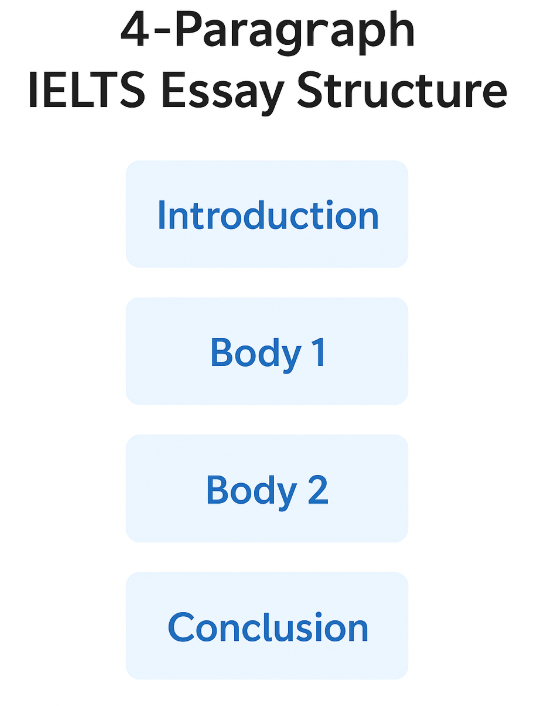Introduction
A lot of students lose marks not because they have weak ideas, but because their IELTS Writing Task 2 essay structure is unclear. In this post, I’ll show you the exact structure I teach my students to boost their scores. When your writing is easy to follow, your message lands better — and examiners reward that in both Coherence and Cohesion and Task Response.
在本篇文章中,我将向您介绍我推荐给所有学生的 4 段式结构。它清晰、灵活,适用于各种类型的任务 2 问题--包括那些令人困惑的 “积极或消极发展 ”问题。

我教学生的四段式结构
This IELTS Writing Task 2 essay structure is flexible, easy to learn, and ideal for Band 7+ writing. I’ve seen it work across every question type — it keeps your ideas organised and your argument focused.
1. Introduction
- 用概括性陈述吸引读者
- 转述问题
- 明确阐述自己的观点
2. Body Paragraph 1
- 提出你的主要支持观点
- 解释清楚
- 举例说明
- 将其与问题联系起来
3. Body Paragraph 2
- 提出反对意见
- 解释一下
- 承认其合理性,但解释其不足之处
- 链接回您的总体论点
4. Conclusion
- 重述您的观点
- 总结两种观点
- 避免添加新信息
💡提示:每个段落应在 90-110 字左右。要突出重点--全面阐述两个观点比简短地涉及四个观点要好。
即使是棘手的问题,这种结构也能奏效
这种方法为您提供了一个框架,您可以根据任务 2 的任何问题进行调整:
- 同意/不同意 → 争论一方或双方
- 讨论两种观点 → 每种观点的正文段落,在引言和结论中提出你的观点
- 问题/解决方案 → 一段描述问题,一段描述解决方案
- 正面/反面发展→一段论述优点,一段论述缺点(或两段都论述一边,取决于你的立场)。
无论采用哪种形式,你的想法都会清晰地表达出来,而这种清晰度会使你的得分产生真正的差异。

想知道自己的做法是否正确吗?
If you’ve written an essay and want to check whether your IELTS Writing Task 2 structure is helping or hurting your score, try our IELTS Task 2 feedback tool. You’ll get detailed feedback with scores, grammar advice, and practical suggestions for improvement.
👉 获得雅思写作反馈 (您将进入一个安全表格,在此提交论文并安全付款。1 分钟内即可得到反馈)。